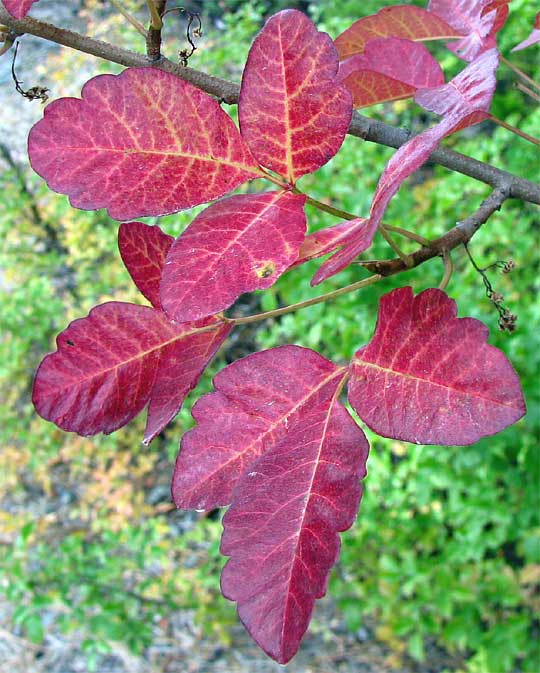Excerpts from Jim Conrad's
Naturalist Newsletter
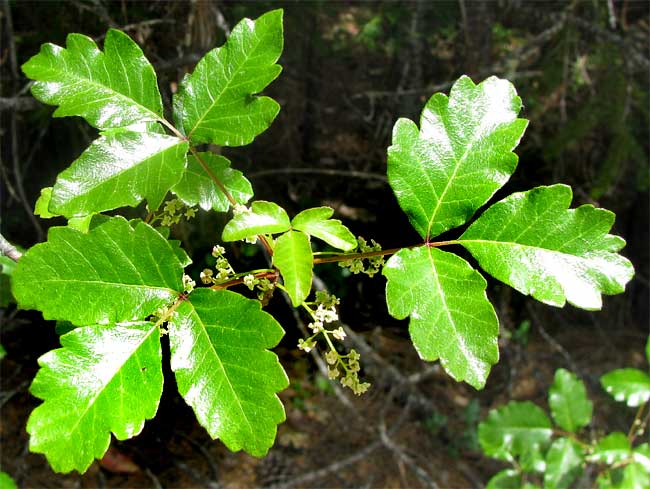
from the the June 7, 2009 Newsletter, issued from the Siskiyou Mountains west of Grants Pass, Oregon:
POISON OAK FLOWERING
Poison Oak, TOXICODENDRON DIVERSILOBUM, is abundant here, forming dense thickets along roads and appearing more dispersed in the general forest. It's so common that if you're allergic to it you'll have a hard time being out much and staying away from it. You can see its flowers and glossy, trifoliate, compound leaves above.
This species, T. diversilobum, is more precisely referred to as the Western or Pacific Poison Oak in order to distinguish it from the Atlantic Poison Oak, T. pubescens. Our T. diversilobum occurs along western North America's Pacific coast and a bit inland, while the eastern species occurs all through the East and makes it as far west as Texas and Kansas.
Sometimes it can be tricky distinguishing the various poison ivies from the various poison oaks. In general the species of poison ivy are viny while the poison oaks are shrubby, and poison ivy leaves bear sharp-pointed lobes while poison oak's lobes are blunter, sometimes almost rounded, as in the photo. Most of our Western Poison Oaks are waist to chest high but sometimes you see one ten feet or more leaning against a tree trunk. You can almost see it thinking about being a poison ivy.
During the winter when leaves are off sometimes you find something and don't know whether it's a poison oak or ivy, or something else. A good field mark for poison oaks and ivies is that of whether its buds bear scales. Poison oak and ivy buds bear no scales, as shown below:
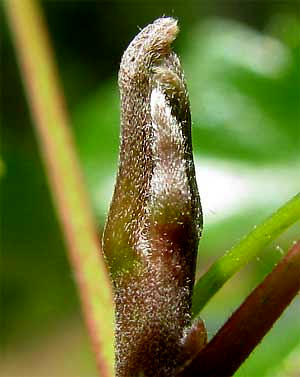
That's one of our poison oaks' terminal buds. You're looking at two future compound leaves, one leaf forming the brown bud's left side, the other the right. Most of the bud's bottom parts are composed of the two leaves' petioles. If you look closely you can see the future leaflets at the buds' very top, heavily covered with protective hairs. If this were a more typical bud, of a maple or an oak, for instance, the leaves would be protected by overlapping, more or less triangular bud scales. The unscaled buds of poison oak and poison ivy are said to be "naked."
from the August 23, 2009 Newsletter, issued from the Siskiyou Mountains west of Grants Pass, Oregon:
POISON OAK'S RED LEAVES
Somehow the feeling here, at least for me, quickly has gone directly from
"springy" to "fallish." Back East one of fall's first signs is when a few leaves of Poison Ivy that's climbed high into a tree turn red. Here something similar happens with Poison Oak, shown below:
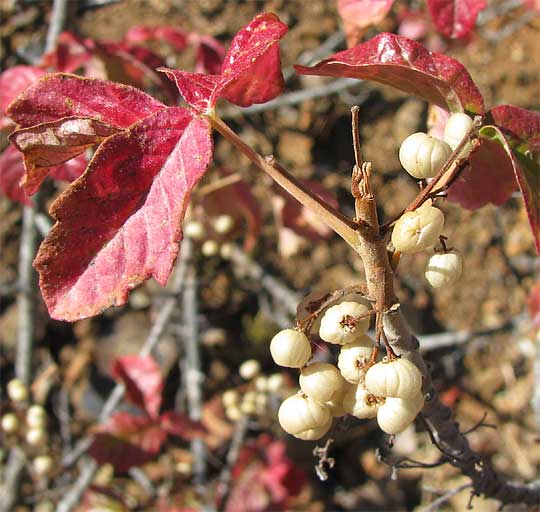 .
.
Most Poison Oak shrubs still are green. The Poison Oaks that are turning red occur mostly in very dry spots, as on ridge crests and cliff edges.
You can see that Poison Oak's drupe-like fruits are a bit larger than those of Poison Ivy, and shaped more like irregular pumpkins than Poison Ivy's round tennis balls. As with Poison Ivy, Poison Oak fruits are much eaten by birds. Moreover, studies show that in some areas Poison Oak foliage, despite causing such a problem for certain people, is the most important browse for Black-tailed Deer.
Some people believe that drinking the milk of Poison-Oak-fed goats bolsters the immune system against Poison Oak because the poison is present in the milk in trace amounts. Analysis of milk from goat-does fed a straight poison-oak diet for three days showed no trace of the compound causing Poison Oak's irritation, which is called urushiol. Some urushiol was present in the does' urine, though.
from the September 20, 2009 Newsletter, issued from the Siskiyou Mountains west of Grants Pass, Oregon:
VINY POISON OAK
During most of my life I've thought of Poison Ivy as a vine and Poison Oak as a bush. Now look at the image below:
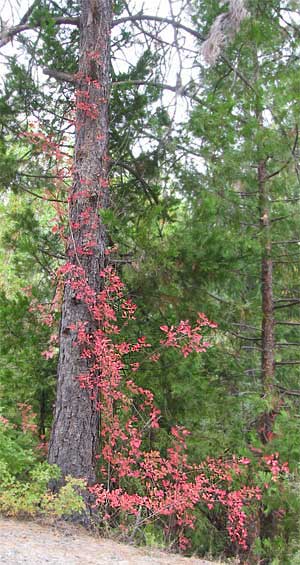
Leaves of our abundant Western Poison-Oak, TOXICODENDRON DIVERSILOBUM, are turning red now and that's one in the picture. Notice that the right side of the plant behaves as a shoulder-high bush, exactly as it appears along roads and at wood edges, but at the left a branch has let loose and climbed into a Douglas-Fir as if it were Poison Ivy.
Actually, its climbing isn't exactly like that of Poison Ivy; its woody stem is much looser attached to the tree trunk than would be a Poison Ivy's. However, its stem does indeed produce adventitious roots anchoring it into the tree's bark, as shown below:
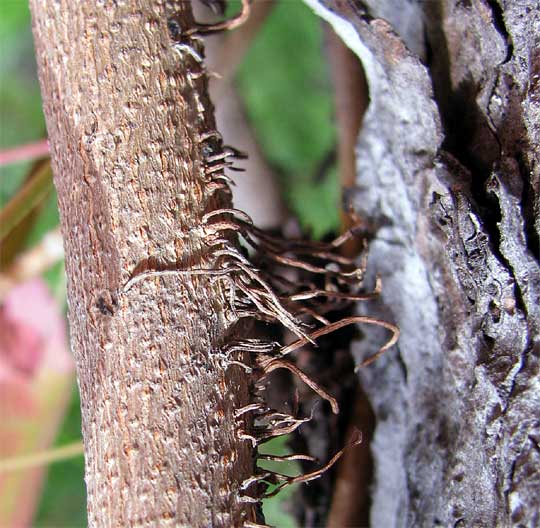
Below you can see the plant's pretty, trifoliate leaves as well as some dried, withered inflorescences. They're dried inflorescences instead of fruits because the plants are dioecious -- producing unisexual flowers on separate plants. That's a male bush/vine in the picture so naturally it'd not bear fruits.
